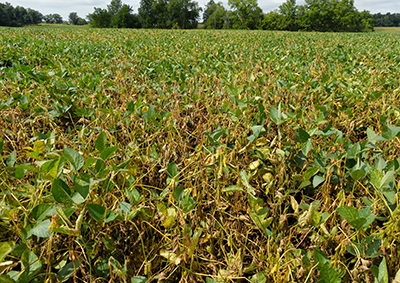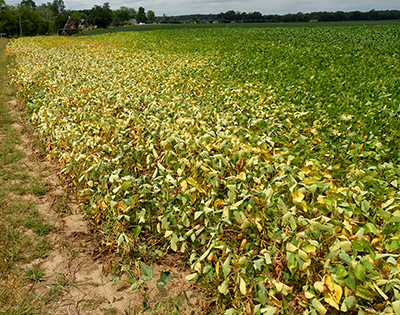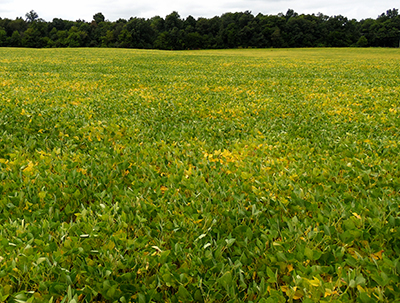Soybean producers will need to understand and implement short-term and long-term management practices to reduce the occurrence of white mold, sudden death syndrome and soybean cyst nematodes, and produce high soybean yields under irrigation.

Photo 1. White mold foliar symptoms in a dense soybean canopy
Two diseases, sudden death syndrome (SDS) and white mold, are showing up in irrigated soybeans this summer. This is not surprising as irrigation water applications are known to promote both diseases. White mold (Photo 1) is promoted when irrigation water is applied prior to and during flowering. Irrigation frequency is also directly related to white mold development. In general, less frequent irrigation water applications at higher application rates are less likely to promote white mold development than more frequent applications at lower rates.
Irrigation water applied before or during the reproductive stages can also induce above-ground SDS symptoms (Photo 2). This is most likely to occur if the water applications create saturated conditions in compacted soils. This was apparent in an area of a soybean field that was irrigated according to a corn irrigation schedule rather than a soybean irrigation schedule (Photo 2). The SDS was more severe and more advanced in this area of the field than it was in the area watered according to the soybean irrigation schedule.

Photo 2. Severe SDS infestation aggravated by excessive irrigation.
To manage white mold, producers should select tolerant varieties, reduce planting populations, increase row spacing, delay irrigation water applications until R3 if possible and reduce inoculum through crop rotation with non-host crops, careful tillage decisions, and use of biological control products such as Contans or KONI.
Selecting tolerant varieties and reducing soil compaction are the most effective methods for managing SDS. Producers should consider planting severely infested fields last as cool, wet conditions occurring at or shortly after planting encourage SDS infection. Soybean cyst nematodes (SCN) can increase SDS infection, so producers should test SDS infested fields for SCN and plant SCN-resistant varieties if detected.
The dry corners of many irrigated soybean fields showed signs of severe moisture stress in August (Photo 3). In many cases this is strictly an environmental stress and not a result of disease. However, pests such as SCN and SDS are likely to build up to damaging levels in dry corners where soybeans are frequently planted. Both SCN and SDS can be spread beyond the dry corners with tillage operations.

Photo 3. Severe moisture stress in a non-irrigated area.
Some soybean fields are beginning to senesce. Producers should distinguish the yellow foliage produced when soybean plants senesce from the foliar symptoms produced by white mold, SDS, SCN and drought. Ideally, senescence will be fairly uniform across the field (Photo 4). However, plant stress generally hastens soybean senescence. For example, compacted headlands will either senesce earlier or later than the rest of the field depending on soil type and soil moisture status.

Photo 4. Beginning of soybean senescence.
Soybean producers will need to understand and implement short-term and long-term management practices to reduce the occurrence of white mold, SDS and SCN and produce high soybean yields under irrigation.
Source : msu.edu